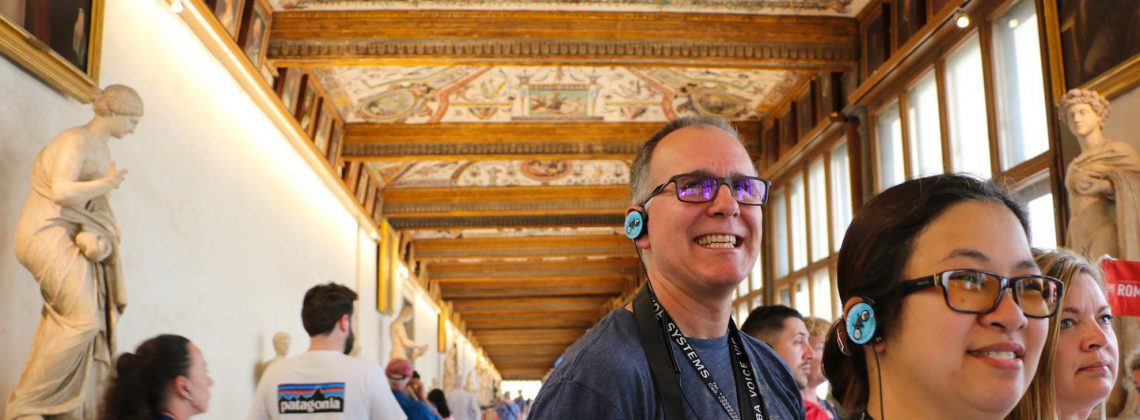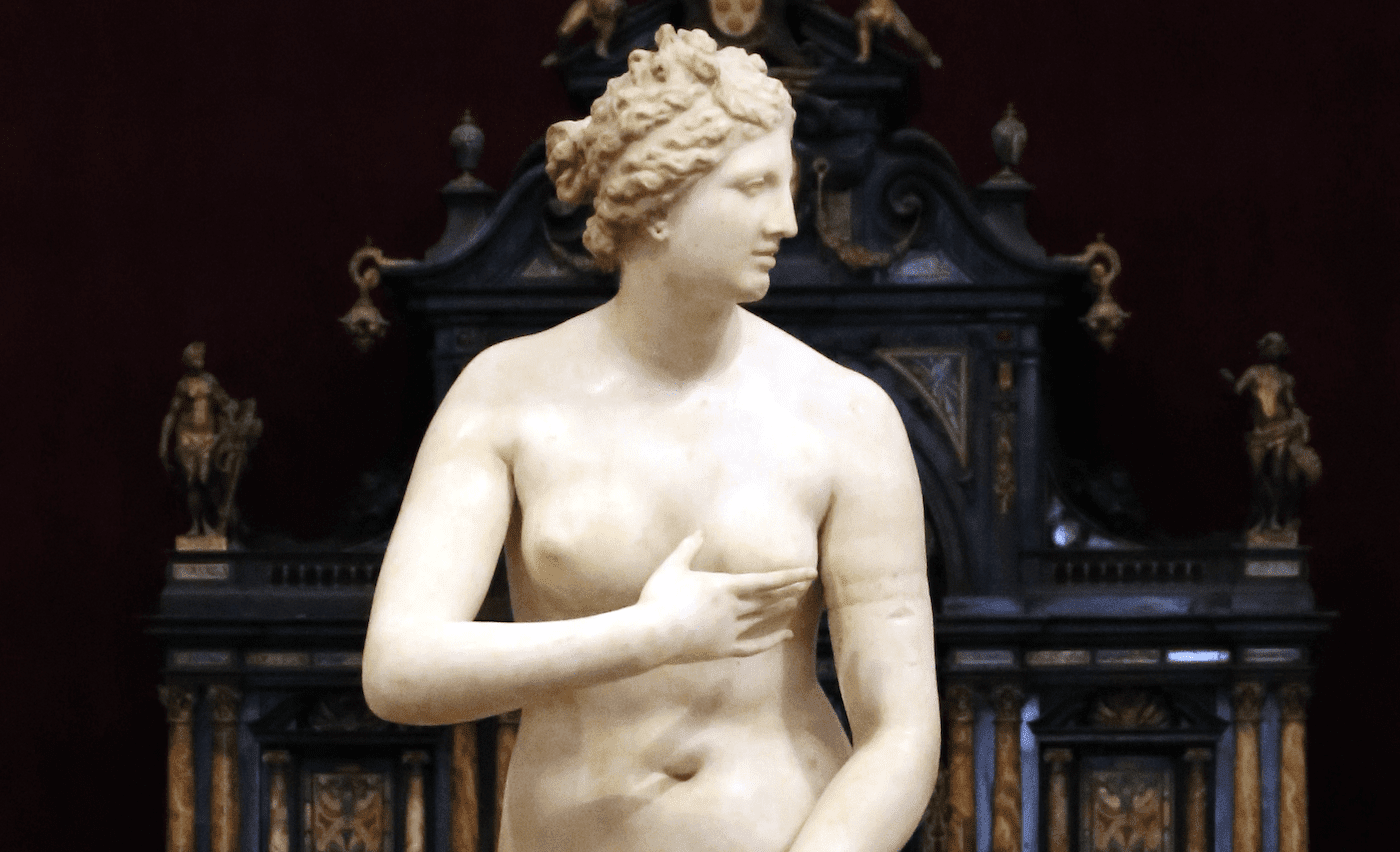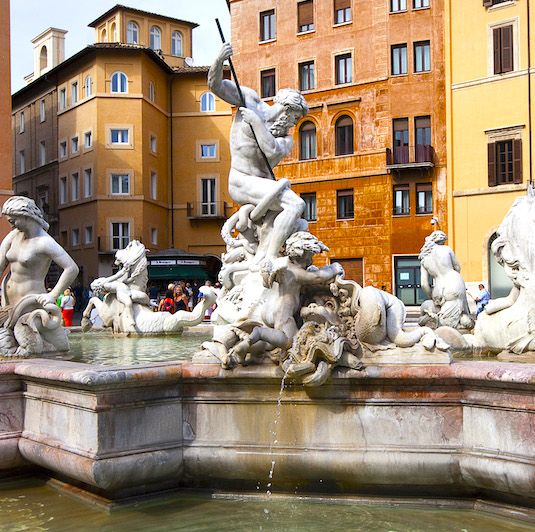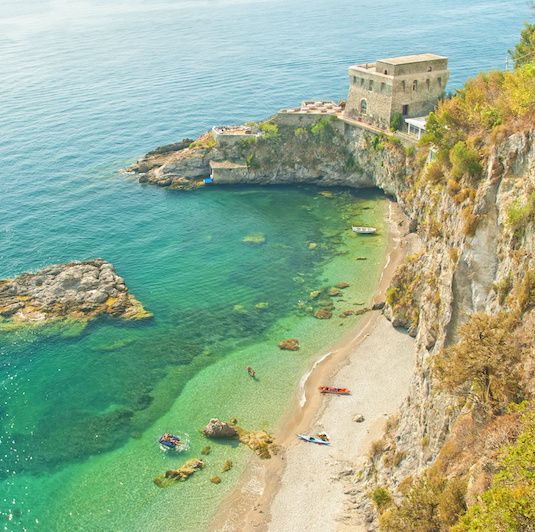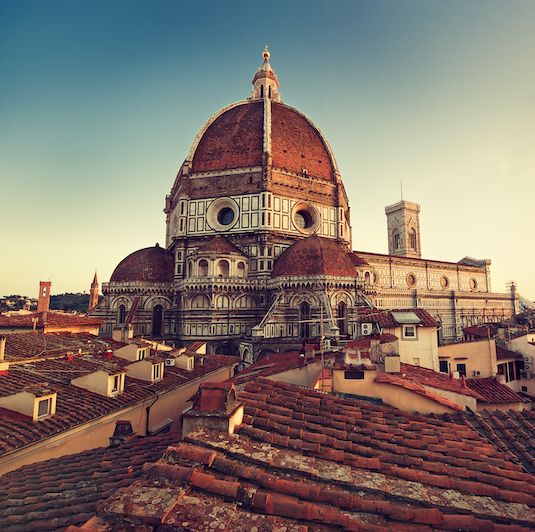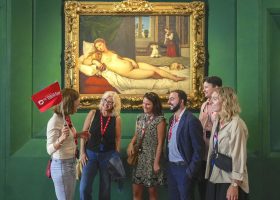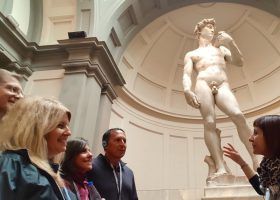The Uffizi Gallery is a must-see Florence museum. If you’re planning to visit the Uffizi and want to know what to see, this article is for you. We reached out to our top local guides in Florence and asked them what we absolutely have to see when visiting the Uffizi Gallery. Here’s what they said.
Pro Tip: It’s easier to organize your trip when you have all your resources in one place. Bookmark this post so you can easily find it when you need it. Check out our Uffizi Gallery guide for more info, our best Uffizi tours for a memorable trip, and how to see Florence in a day (with itinerary).
Must-See Works of Art at the Uffizi Gallery
For many of us, museums are buildings that have been specifically designed and built to exhibit exceptional works or art. For Italians, that is quite often not the case.
The Uffizi Gallery, for example, was originally built by the Medici family to serve as offices. The name “uffizi” literally means just that. Great patrons of art, it comes as no surprise that the Medici loved art, so much so that they filled their offices with it.
Eventually, the space became so ornate that people began visiting by request as early as the 16th century. In 1765, the last Medici heiress, Anna Maria Luisa de’ Medici signed over almost all Medici assets to the Tuscan State in the Patto di Famiglia. This included the Pitti Palace, Uffizi, and the Medicean Villas.
This was a monumental move considering that one Medici violin built by Antonio Stradivari, currently in the Accademia Gallery of Florence, would sell for over $16 million. It made it possible for over 4 million visitors to enjoy the masterpieces in the Uffizi each year.
By 1865, the Uffizi Gallery was officially referred to as a museum. Here are the must-see masterpieces currently housed in the Uffizi Gallery.
Not ready to book a tour? See if an Uffizi Gallery tour is worth it.
12. Balcony Overlooking the Duomo
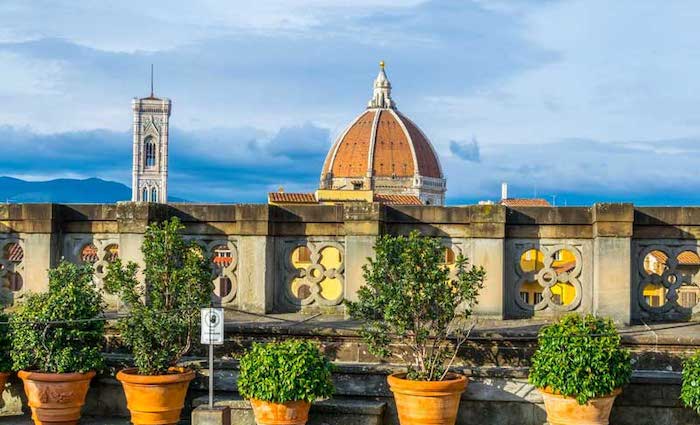
Head to the balcony of the Uffizi Gallery for an incredible viewpoint overlooking some of Florence’s greatest works of architectural art—the Duomo. However, the whole city could be defined as one large masterpiece, like many other Italian cities.
As you look out, the first thing you’ll notice is Brunelleschi’s dome on the Cathedral of Santa Maria del Fiore aka Il Duomo. When it was built, the dome was the largest in the world and it remains the largest brick dome in existence. The dome itself is larger than the dome of St. Peter’s Basilica; however, St. Peter’s Dome, by Donato Bramante, is significantly taller in height.
You’ll also see Giotto’s bell tower, which was constructed in the 14th century by Giotto di Bondone. While it appears to be part of the cathedral, it isn’t. There’s a few feet separating the two—just enough space to walk between them.
The tower was designed by Giotto, but it was not finished in his lifetime or that of his successor, Andrea Pisano. It was ultimately completed by Francesco Talenti in 1359. The tower has 414 stairs and there’s a terrific view from on top if you’re up for it. To find this viewpoint and get a coffee, follow the numerous signs leading to the “Bar” inside the Uffizi.
11. Portraits of the Duke and Duchess of Urbino
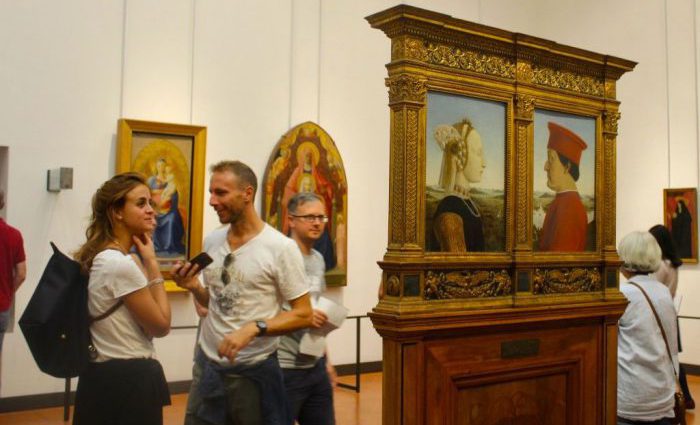
Piero della Francesca | 1472 | Oil on Wood | Hall No. 7
This is an interesting and peculiar oil on wood painting depicting a very powerful couple, Federico da Montefeltro and Battista Sforza. The Sforza family ruled Milan for hundreds of years. The painting dates back to the late 15th century and is in fantastic condition.
The painting may look odd and cold but it’s actually very romantic—it’s just difficult to see as it’s currently displayed. This is because the original painting had no obstruction between the two figures.
The two wood panels were originally connected by a hinge. In essence, you’d see no obstruction between the couple and they would appear to be gazing into eachother’s eyes. This style is called diptych and is often placed on an alter or even closed like a book.
While portraits of this kind connected with a hinge are not uncommon, this one features a rarity. The artist painted the wood panels on both the front and back sides. The back features a horse-drawn carriage and a unicorn-drawn carriage, which are allegories of triumph.
The triumph is not from a great battle, but one of virtues. This time period was extremely conservative and focused on morals. The duke features the virtues of justice, wisdom, valor, and moderation, while the duchess features faith, hope, and charity.
10. The Ognissanti Madonna
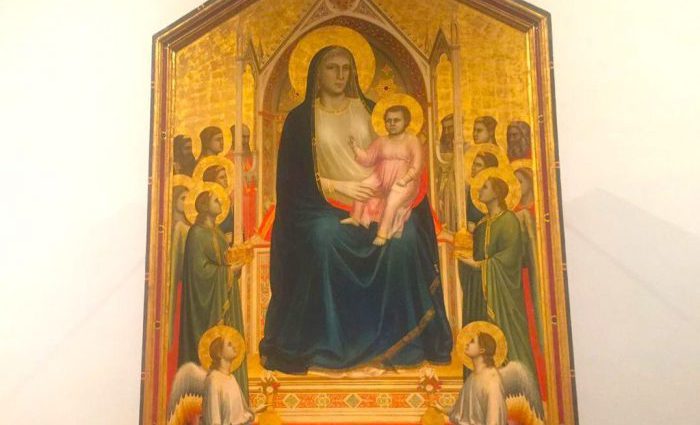
Giotto di Bondone | 1310 | Tempera on Panel | Hall No. 2
Giotto di Bondone painted the Ognissanti or Madonna Enthroned in the late medieval period (Proto-Renaissance) on a wood panel. Giotto was one of the most influential artists leading up to the golden era of the Renaissance, which is why his art receives so much recognition.
Although this is not the first appearance, Giotto is the first western-European artist to depict three-dimensional figures. What he did was a catalyst for a new wave of art, which was considered highly innovative by artists like Botticelli and Michelangelo who would come into their prime more than a century later.
He started Ognissanti Madonna the year after he finished his frescoes in the Scrovegni Chapel, which were his masterpieces and a supreme masterpiece in Western Civilization. Why was the chapel so important and what does it have to do with Ognissanti?
Many reasons, but most notable was the change in style. The beginning of the Renaissance dates to 1300, and Giotto’s chapel was completed in 1305. Without argument, Giotto’s Scrovegni Chapel is the first masterpiece of the Renaissance and it was immediately accepted with high regard. Paintings began to show individuals instead of groups and artists began to take credit.
Giotto must have started Ognissanti at least a few months after finishing the chapel and came at it with vigor. The painting would come to find it’s home in Florence and inspire many locally. While the painting definitely shares the rigidness of Byzantine art, which can be torturous at times, it shows signs of artistic evolution—specifically the 3-dimensional figures.
Popular Florence Tours
Not ready to book a tour? Check out our article on the best Florence tours to take and why.
9. Medusa
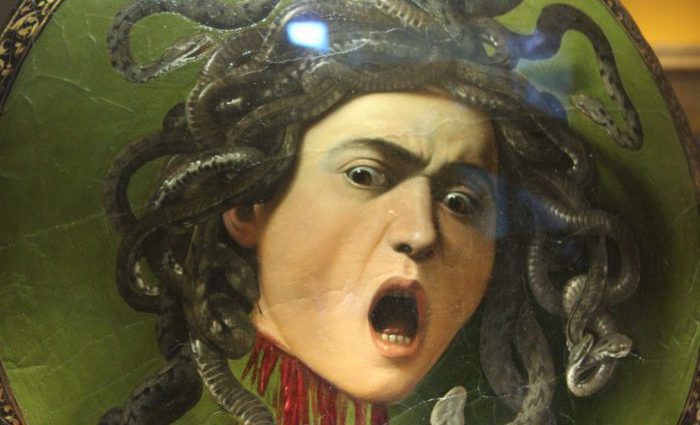
Caravaggio | 1596 | Oil on Wood | Hall No. 90
Caravaggio was sort of like the Quentin Tarantino of the baroque period. He painted grotesque gripping artwork that turned heads. His Medusa is no exception.
From Milan, Caravaggio was born Michelangelo Merisi. He went by Caravaggio because no one could really go by the name Michelangelo after the Michelangelo. His parents died at a young age and was an orphan by 16.
He painted dramatic scenes that would most definitely have made the people of his time feel uncomfortable. They may even make you feel uncomfortable today.
You have to imagine how much changed in the almost 300 years between the Ognissanti and Medusa. Ognissanti is considered controversial for its time because it portrays members of a painting as individuals looking in different directions. Medusa has her head chopped off, screaming with Pulp-Fiction-level blood squirting everywhere.
It was commissioned by Cardinal Francesco Maria Bourbon de Monte in 1597 who then gave it to the Grand Duke Ferdinando I de’ Medici as a gift (or maybe re-gift?). It is painted on a quasi-shield since Perseus used a shield as a mirror to see Medusa when he beheaded her.
8. Venus of Urbino
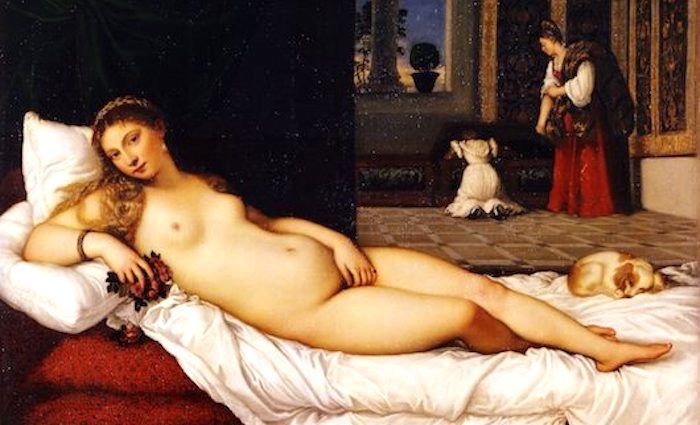
Titian | 1538 | Oil on Canvas | Hall No. 83
The Venus of Urbino was completed by Titian in 1538 and commissioned by the Duke of Urbino, Guidobaldo II Della Rovere. The painting was a gift from the Duke to his young wife.
It represented the allegory of marriage: eroticism, fidelity, and motherhood. The eroticism is evident in the representation of Venus, the goddess of love. The dog at her feet represents marital fidelity and the girl looking through the chest in the background represents motherhood.
7. Self-Portraits
Rembrant | 17th Century | Hall No. 49
Rembrandt is a very important figure as he carried the Italian Renaissance north to Holland where the Dutch Renaissance began. He lived during the 17th century and has two self-portraits.
First as a young man and another as a mature man. He followed the path of Caravaggio by painting in a chiaroscuro method to draw attention to key features and create drama. You’ll find several Rembrandt paintings housed in the Uffizi including The Old Rabbi.
6. Doni Tondo (The Holy Family)
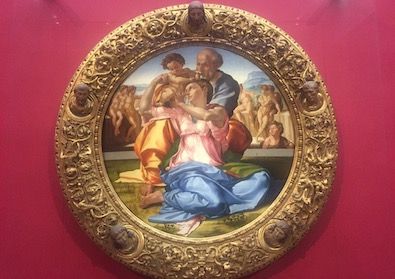
Michelangelo | 1506 | Oil on Wood | Hall No. 3
Doni Tondo or The Holy Family is one of a literal handful of free-standing (panel) paintings by Michaelangelo and this is the only one that has survived. Commissioned by Agnolo Doni in 1506, the name, Doni Tondo, is very literal. Doni is the last name of the patron and tondo means “round” in Italian—hence the shape of the painting.
The merchant Agnolo Doni commissioned Michelangelo to paint this to celebrate the birth of his child and/or his marriage. It’s a beautiful work of art that commemorates a sort of golden era for Renaissance art in Florence. The frame is also original to the painting, which Michelangelo would likely have designed himself.
Although Michelangelo lived in a heavily documented era, there’s a lot of unknowns surrounding this work of art. The frame depicts five figures, which are largely unknown.
The nudes in the background also hold little significance and their meaning is speculative at best. A major question is if Mary is passing the baby to St. Joseph or visa versa. This is Michelangelo’s only free standing painting, which makes it a unicorn.
5. Medici Venus
Praxiteles | First Century B.C. | Marble | Hall of Tribunes
It is likely that Venus, or Aphrodite in Greece, is the most sculpted figure in history. This is largely due to what she represents—love. The Medici Venus is a 1st century B.C. copy of a Greek sculpture.
The sculpture was taken into ownership by the Medici and attributed to Praxiteles, but there’s little foundation for that. The base says it was sculpted by the son of Apollodorus, but that is not true.
Regardless, it is a beautiful sculpture. As you admire it, you can connect with many famous historical figures such as Michelangelo, Botticelli, or Lorenzo the Magnificent who undoutedly admired it up close.
4. Annunciation
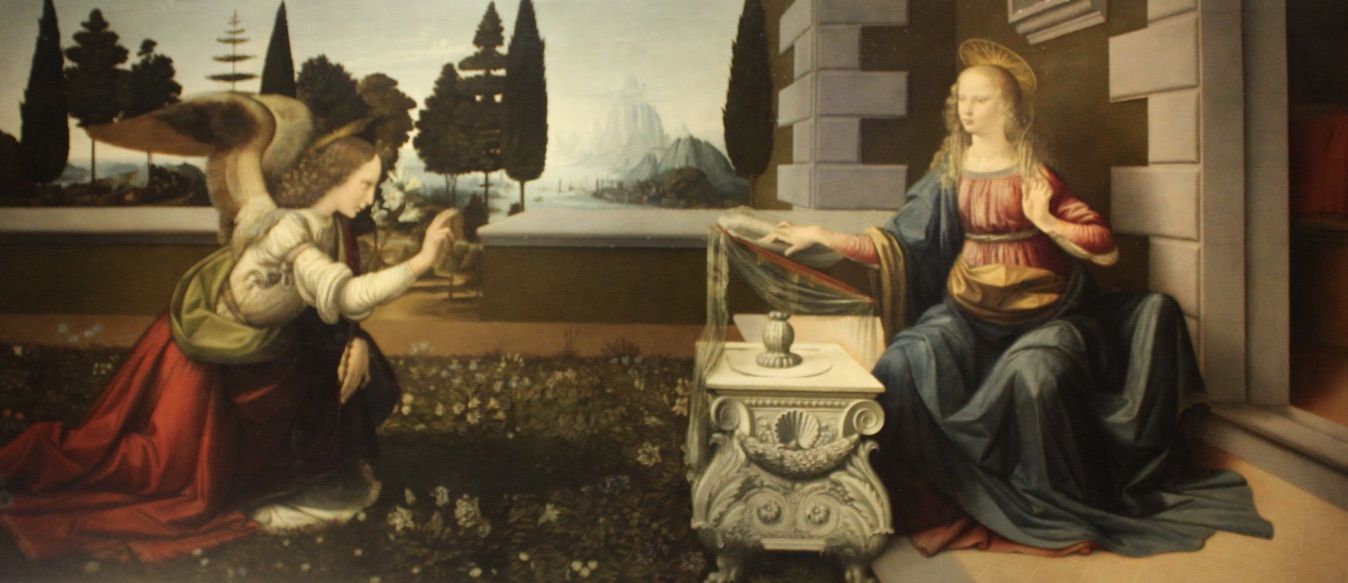
Leonardo da Vinci and Andrea del Verrocchio | 1475 | Oil on Wood | Hall No. 15
The Annunciation is widely accepted as Leonardo da Vinci’s first commissioned painting. He painted the Annunciation in his early twenties as a young man, and it already shows all the tell-tale signs of a “da Vinci.”
The painting features the Angel Gabriel who is communicating to the Virgin Mary that she will conceive and give birth to a son to be named Jesus, “Son of God.”
The work of art would have been greeted with universal acclaim as the style was almost completely unique. Leonardo loved nature, which is very present in this painting.
He set a new precedence for spatiality in this work with his layout of the mountains, stream, and trees. The perception of depth, use of bold colors, and unique details brought da Vinci more commissions than he could handle.
Hopefully, I won’t ruin this painting for you, but it’s hard not to mention that this painting looks like the angel is taking a photo of the Madonna, does it not?
3. Madonna del Cardellino
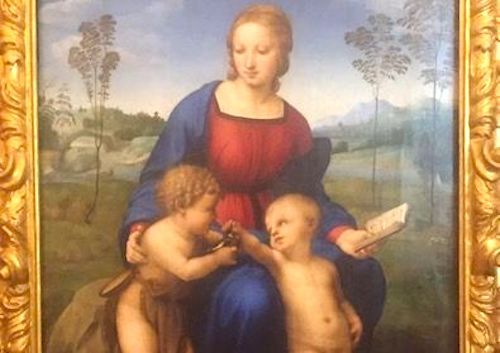
Raphael | 1506 | Oil on Wood | Hall No. 66
The Madonna del Cardellino, or Madonna of the Goldfinch, is a work by the master Raphael. It was a wedding gift for his friend Lorenzo Nasi. The Virgin Mary is young and beautiful in this painting, wearing red and blue robes. The red signifies the passion of Christ and the blue represents the church.
The painting features the Madonna, mother of Christ, St. John as a baby (left), and Jesus Christ (right). John holds a goldfinch, which is a symbol of the crucifixion.
According to Christian dogma, a goldfinch came down to take a thorn from the crown of Christ and was splattered by a droplet of blood. From then on, goldfinches have always had a red dot on their breast.
The painting has been on a wild ride from 1548 until 2008. It was broken into 17 pieces during an earthquake in 1548 and restored, but you can still see many cracks. Raphael had been dead for some time at this point and the painting was of significant importance.
In 2002, the painting underwent a scientific restoration over the course of six years and has been hanging in the Uffizi since 2008. It is now closer to its original condition than it has been since 1548.
Popular Florence Tours
Not ready to book a tour? Check out our article on the best Florence tours to take and why.
2. La Primavera
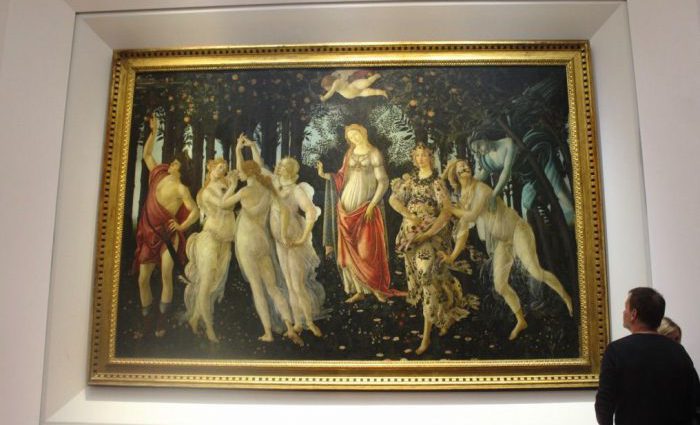
Sandro Botticelli | 1480s | Tempera on Panel | Hall No. 10-14
La Primavera, or Spring in English, is one of the greatest works of art ever blessed upon the world. That statement goes far beyond its beauty and artistic expression.
La Primavera defied the oppression of artistic expression, which arguably could have inspired a massive leap forward in art history. Some of the greatest artists that would ever live followed the career of Boticelli.
The Medici family commissioned the painting and it only exists due to their wealth and clout. The 15th century was the height of the Renaissance in Florence, and this would have been one of the first paintings to feature a completely pagan scene introduced to the public.
In Rome, people were burned at the stake for less. But this was Florence, and the Medici ruled. The painting symbolizes so much in terms of progress and freedom of expression but it is also a masterpiece in terms of artistic ability.
From right to left, you have Zephyr, who symbolizes the spring wind, and the nymph Clori. Their daughter, Flora, goddess of flowers, is the spring. In the center, you’ll find Venus as a symbol of love. To the left of Venus are the Three Graces and Mercury.
Botticelli is a trailblazer with his accuracy in depicting the human body. Much of the reason why he portrays people in the nude or partially nude is to feature his skills.
The painting was commissioned for the Medici whom Botticelli was very close to. It is riddled with Medici symbolism and there are even some Medici faces—it’s practically a year book. For example, the name Medici means “doctors” in Italian, and Mercury was the god of medicine.
1. The Birth of Venice by Sandro Botticelli
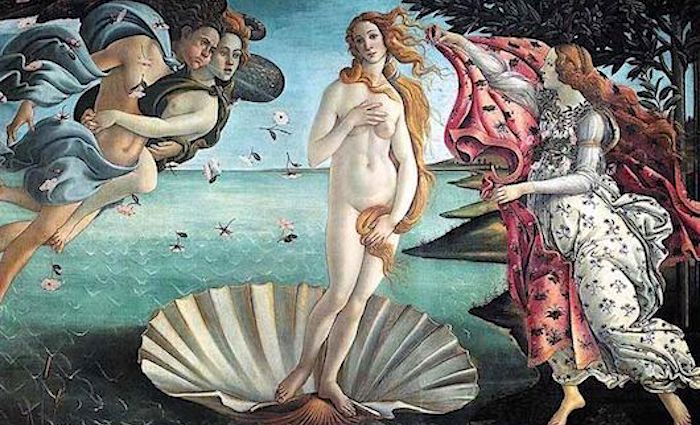
Sandro Botticelli | 1485 | Tempera on Canvas | Hall No. 10-14
The Birth of Venus has become one of the world’s most famous Renaissance masterpieces.It was painted by Sandro Botticelli between 1482 and 1485 for the Medici family. If La Primavera was the first step in freedom of expression, then the Birth of Venus was the first big leap.
In the painting, you see Venus, the goddess of love, standing on a seashell in the center. To the right of her, Zephyr, the god of the west wind is blowing her to the shore. There, Pomona, the goddess of spring, is waiting with a cape to clothe the newborn deity.
Artistically, it is much brighter than La Primavera with a more open landscape behind Venus. Instead of partially clothed, Venus is almost completely nude—risky for the period. The subject is said to be modeled after an Aphrodite statue named Aphrodite of Cnidos, but romantics believe it was Simonetta Vespucci, the wife of a Florentine trader.
This rumor has been all but dismissed by art critics, but I sure do like a good story. Botticelli apparently fell in love with her while painting a commission for her husband, Marco Vespucci. Her likeness is arguably found in many of Botticelli’s works, but it is heavily refuted.
The Birth of Venus is one of the greatest paintings from the 15th century and likely the most beautiful depiction of Venus in history. On a personal note, I was so inspired when I saw this painting for the first time that I made the decision to leave a life of banking (Wall Street) and work in tourism.
Not ready to book a tour? Find out if an Uffizi Gallery tour is worth it.
Here Is Where to Stay in the Most Popular Italian Destinations
Rome, Florence, Venice, the Amalfi Coast, and Capri
